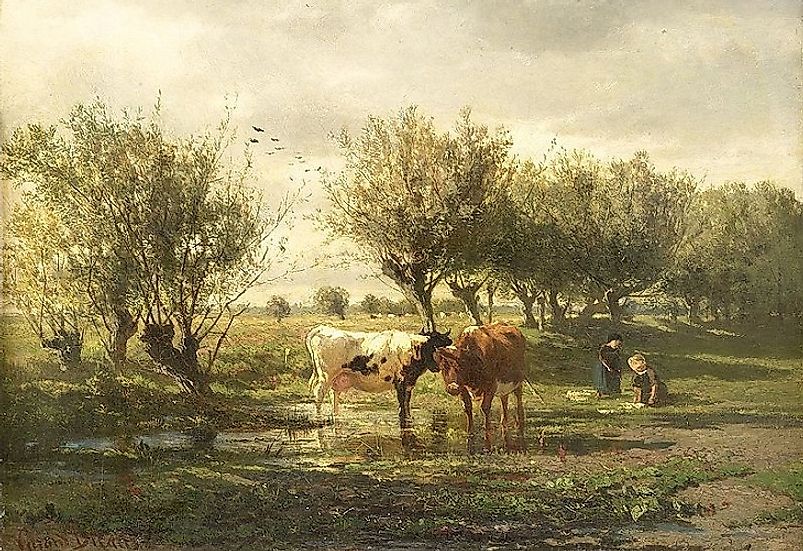Hague School Of Dutch Art

5. Overview of the Style -
The Hague School of Dutch Art refers to a Mid to Late 19th Century style of painting that incorporated dark, almost gloomy, colors. Because of its reliance on various shades of grey, this artistic style is also known as the Grey School. Most of the paintings use landscapes and everyday scenes common to the Netherlands as inspiration, which includes windmills, farmers, ships, fishermen, and sea views.
4. History and Development -
The Hague style began to take shape around 1860, three decades after the Romantic Period of Dutch painting. Some of the best Romantic artists focused on landscapes as well and went on to teach at the Hague School of Art. The lessons during this time focused on drawing rather than painting and many students, who would go on to become famous Grey School painters, decided to supplement their classes elsewhere.
At a National Exhibition in Brussels, Gerard Bilders displayed several paintings with a grey overcast tone, which became the basis for the Hague School. He introduced this style to some friends who had gone to paint the landscape near Oosterbeek village. In the late 1860s and early 1870s, the group of friends began moving to the The Hague. Here, they worked closely together and when one person had an exhibition invite, he would make sure that everyone in the group was able to submit a piece of work as well. In this way, the grey tonality of the Hague School became recognized. The term Hague School was first used in 1875 as a way to describe the mood of these paintings. This was exactly the intent of the artists, to focus on the mood of the atmosphere rather than portraying the landscapes as they were seen.
3. Notable Artists and their Works -
Gerard Bilders was one of the most notable of the Hague School artists, as well as the first to use the grey tonality and somber mood. Many of his paintings centered around pastures and cattle. Some of the most recognizable include Cows at a Pond, Meadow near Oosterbeek, and Cows in the Pasture.
Jacob Maris is known as one of the most important Dutch landscape painters of the latter 19th Century. Some of his most famous works include Ship on the Scheveningen Beach, Village near Schiedam, and The Windmill. Each of these paintings reflects the serious, dark mood of the Hague School style.
Other notable Hague School artists included Hendrik Willem Mesdag, Anton Mauve, and Lambertus Hardenberg.
2. Decline and Subsequent Successive Movements -
By the mid-1880s, the Hague School began to drift apart as the city it was based from started to grow and develop. The artists sought other landscapes to paint, outside of The Hague. Additionally, other artists began focusing their works on different subject matters. For example, the interior of country homes became popular rather than country and seaside landscapes. Those artists who remained in the city began to focus on urban life, which later became the Amsterdam Impressionism. Still others began to incorporate brighter paints in their works.
1. Legacy -
As previously mentioned, the Hague School of Dutch Art movement developed into the Amsterdam Impressionism style. Eugene Boudin of the Impressionism art movement later went on to teach Claude Monet. This style developed into Post-Impressionism and the use of abstract shapes and cubism. This style was made most famous by Vincent Van Gogh, who was trained by the Hague School artist Anton Mauve.







